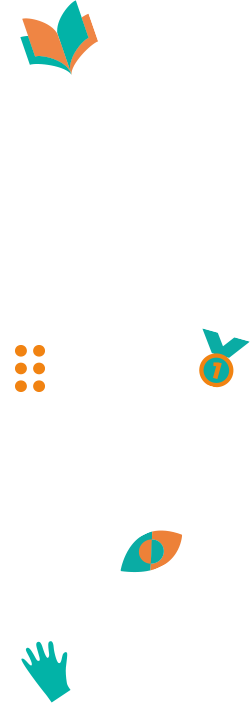The content of a tactile book depends on the child’s age, disability, level of development and experience.
In books for very young children, it is important to strictly follow certain rules; as the child grows and his/her experience increases, it will be possible to “break” these rules in some cases.
HANDWORK
- it must be robust;
- it must have rigid pages (cardboard or fabric), with rounded corners;
- the binding must allow the pages to be opened horizontally for tactile exploration of each page and to properly close the book;
- the text must be in large print 16 pt. and in Braille;
- the text must always be on the pages on the same side (always on the left or always on the right page) and the same for the illustrations;
- the page format varies according to the age of the child; for the little ones, pages of 15x15cm then 20×20, then 25×25, then 21×29.7, as the child grows and his exploration skills increase;
- the number of pages also depends on the age of the child; you can start with a few pages (5-6) and gradually increase the number;
- a base line at the bottom of each page helps the child orient the book.
INTERIOR
- it must be completely safe: avoid sharp objects, toxic materials, small objects which could come off and be swallowed, long ribbons, etc., which could strangle. Use strong, safe and sanitary materials that are firmly attached to the pages;
- for the first books:
- use only one small object per page or several objects of the same type;
- use real objects on the page and gradually move on to object representations, then to stories and situations;
- it can be useful to attach objects with Velcro® to allow the child to feel the object in the book, but also to extract it, explore it and recognize it as a real object (this facilitates the transition from reality to representation in the book);
- illustrations must be relevant, clear and simple,
- stories should be simple enough to be easily understood. At the beginning, images and stories must relate to everyday life and reality, then we can introduce the imaginary and later abstract ideas;
- avoid too many details on the page;
- illustrations should encourage manipulation, be interesting and allow interaction;
- the illustrations must relate to an essential part of the story and complement the text;
- use multi-sensory materials that stimulate not only touch but also hearing, smell and residual sight if necessary;
- take into account good contrasts between objects and between objects and the page background. Reflective materials can be very useful but some partially sighted children are embarrassed by anything that dazzles;
- watch out for the strong contrasts of the tactile sensations and of the different textures;
- use different textures to represent different parts of an object;
- make sure the details are easily identifiable;
- leave sufficient space between two elements on the page;
- avoid overlapping (element on top of another which partially hides it);
- respect proportions and avoid perspective;
- the human figures are best represented from the front, while the animals must be represented in profile (with 4 legs);
- if a character appears more than once in the story, he must keep the same characteristics;
- the thickness of the materials glued on the pages must have a minimum height of 1mm.
TEXT TO BE READ
To be accessible, the text of your tactile book must be written :
- in raised Braille,
- in black (i.e. in ordinary writing as opposed to Braille) with a sans serif font (e.g. Luciole, Arial, Tahoma, Verdana, etc.) and in large type (minimum size 16).
The accessibility of the text of your tactile book is an important point: some T&T partners organise a jury including blind people. They will be able to read your tactile book independently. If you need advice on how to lay out the text and print it, contact the T&T partner in your country. They will be able to provide you with technical resources and even contacts for embossing Braille in relief.
BUT ALSO OTHER REFERENCES…
“The Typhlo and Tactus Guide to Children Books with Tactile Illustrations” (Les Doigts Qui Rêvent, Philippe Claudet)
The largest international panorama concerning Tactile Illustrated Books for Visually Impaired Children:
- 428 pages
- 19 countries involved
- 22 contributors
- color photos
- international bibliography
- website contacts
The articles of all these professionals in the field have in common a pioneering side as well as an immense motivation. They gave you here everything they knew, exposed their practice without any reservation, generously, in order to break the isolation of all the authors and producers of tactile illustrated books in the world and especially in emerging countries, convinced that these blind and partially sighted children have the right to books, to access to culture, to the immense pleasure of reading for full citizenship. This T&T Guide reflects the “Tactus spirit”. It is published in French and in English and distributed by Les Doigts Qui Rêvent in the Corpus collection.
The “RESOURCES” section of Les Doigts Qui Rêvent website
This page also includes advice, experiences of mediation with visually impaired children.


